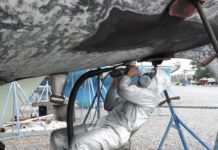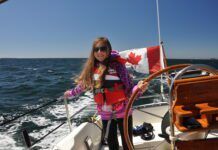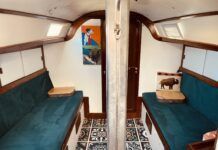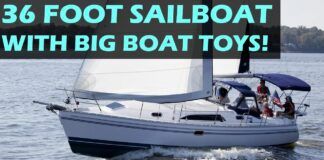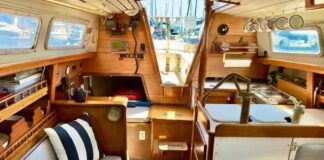Readers who have been with us long are familiar with our yearly tests of bottom paints. Considering how important this paint is to all sailors, it’s no wonder that we do a full-court press on it here, and that the results (this is our 11th annual set of them) are much anticipated. Still, it’s an odd sport and pastime in which so many people can be heard to say “Hey honey—the new bottom paint story is here!” Or “Please, Miss Stanley, no interruptions. I have to choose a bottom coating.”
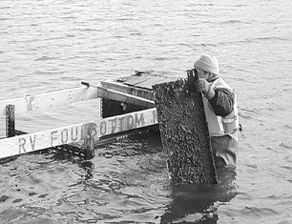
Since last summer we’ve tested 44 coatings, both in Connecticut, aboard the putrid cormorant motel and outhouse, Foulbottom II, and in Key Largo, Florida. The makers of one coating, Bye Bye Barnacles, asked that their product be withdrawn from the testing pending a reformulation, and we complied.
Test Procedures
As in years past, we used polyester/fiberglass panels for the testing. The panels were washed, dewaxed with solvent, sanded, then washed again to remove any traces of wax or particulate matter.
The paint was applied exactly as the instructions on the label require, including any extra pre-treatments. All paints were applied (with different brushes) in the recommended number of coats, and all were dried according to instructions. Only one side of each panel was painted; the other side was left bare.
Each panel was identified by a series of large and small holes drilled in a binary code that corresponds to its numerical ID on our working spreadsheet. This has proved a very reliable marking system, no matter how badly fouled the panels.
In Connecticut the panels were bolted to angle iron racks, which were then bolted to Foulbottom II. In Key Largo the paints were applied in taped-off rectangles on larger, uncut panels of the same material, identically prepared. These panels were drilled in the corners and suspended underwater on PVC pipes from a dock in a waterway.
In both locations we used completely new sets of panels and paints. The results of tests for soft-growth on so-called “multi-season” paints were reported last year (March 2001). We doubt that it makes sense to set up another round of multi-season testing, for two reasons: First, there are an uncomfortable number of variables, with different paints coming in and out of the testing each year, paints coming in and out of the water, the difficulty of scrubbing them or not scrubbing them equitably; the differences between hard and soft paints, the differences in the definition of a “season,” and so on. Second, and more importantly, most owners repaint every year, whether or not they use a “multi-season” paint. We suspect that the results of a one-year (one-season) test can be fairly well extrapolated. Nevertheless, we’ll keep our options open and use the Florida panels for any further multi-season evaluation with this set of paints.
Rating System
It will be noticed by manufacturers and by readers who avidly collect these annual reports (and we hope there aren’t many) that the ratings in the chart this year are more pessimistic than those of last year—for example, many paints that were rated “good” last year are rated “fair” this year. This reflects no change in the paints or the test procedure (although of course we can’t take weather and water conditions into account). The apparent enthusiasm shift is just part of an attempt to apply our standard four-level rating scale to this project. In this case an “excellent” rating means that the panel was completely free of growth; “good” means that a significant portion of the panel, say a third to a half of the surface, showed growth; “fair” means that most or all of the panel showed a thin layer of growth; and “poor” means that most or all of the panel was obscured in a heavier layer of growth. We would hasten to point out that there was no hard growth on any of these panels, and that all of them would be easy to clean with a scrubber underwater.
Types of Paint
The R&D of bottom paint is serious science and chemical engineering, sandwiched between fouling problems on one side and environmental impact problems on the other. The interests of recreational sailors and powerboaters aren’t insignificant, but commercial and military interests are bigger and more important to the paint makers. We get the benefits of that serious research.
The majority of recreational marine paints today are still copper-based, though from there the types diverge into several branches. To quote from our own reports, “A ‘traditional’ bottom paint consists of either metallic copper powder or copper oxide mixed into a film-forming vehicle. This film is either somewhat permeable to water, allowing the water to penetrate it and reach the copper, or it’s somewhat soluble in water, with its outer layer washing off in time to expose a fresh layer of copper. This latter type is described as ‘sloughing’ or ‘ablative,’ or sometimes a ‘co-polymer’ bottom paint. The first type includes ‘hard epoxy,’ ‘modified epoxy,’ ‘oil,’ and ‘alkyd’ paints. Both sloughing and non-sloughing bottom paints are available in water-based (more precisely, water-thinned) forms.”
Though much is made of high copper content in a paint, our tests over the years have indicated that high copper content alone isn’t necessarily an indicator of an effective bottom paint—although, absent other information, it’s a good way to bet. More effective, in recent years, have been varying combinations of copper and epoxy with biocides and algicides.
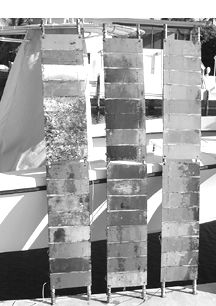
There’s another breed of coating that’s meant simply to be “slipperier” and more difficult for growth to cling to. Interlux’s Veridian is one of these—it’s a silicone-based coating that ends up as an extremely glossy finish with (logically enough) a slightly rubbery feel. It resists fouling easily, tends to shrug off growth with water movement, and is easily wiped clean with a soft cloth or sponge. Coatings like these may represent at least one of the waves of a future in which copper-based paints will need to go the way of the carbureted two-stroke outboard—out the door.
Meanwhile there’s a new kid on the block (at least new to our neighborhood) who stands up to fouling about as well as the copper toughs, but uses a different kind of weapon—Zinc Omadine®. The paint we tested was white EP 2000, from E Paint in East Falmouth, MA. It came out of the water totally free of growth in the New England testing —and we mean spotless. In the Florida test, the panel was about a third covered in thin slime. This was easily wiped off, but underneath there was a brownish stain on the whole panel that would be difficult to remove.
EP 2000, according to the company brief, is “a single-component, high- performance antifouling paint that yields a hard, racing finish. EP 2000 is waterborne for ease of application and clean-up. The product is available in bright-white, gray, and safety orange but additional colors are currently in development. EP 2000 is recommended for use on all substrates, including aluminum.”
While the Zinc Omadine® acts as a biocide, the paint also repels growth with photoactive chemistry in which sunlight reacts with a catalyst to release small amounts of hydrogen peroxide into the water. This helps keep the foulies away, and also represents a negligible environmental threat, since the half-life of the hydrogen peroxide in the water is only about four hours.
E Paint sales director Christine Greene says EP 2000 needs UV light to work, although not much; there doesn’t seem to be a problem, she says, with fouling on deep keels even in fairly murky water. The downside is that dark pigments like blue, red, green, and black—traditional bottom paint colors—block the photo receptors in the paint and can reduce its effectiveness dramatically. The Coast Guard, she says, is still enthusiastic enough about the paint to risk it in their “safety orange” color.
EP 2000 has a softer, ablative cousin, ZO, that works the same way.
EP 2000 is not a cheap coating—at $187 per gallon, it’s more expensive than all the other paints on the list. Only CopperPoxy, which is actually a copper-containing hard epoxy gelcoat formulation that can last for several seasons with only some brisk brushing, and Interlux’s Veridian (mentioned earlier) are more expensive.
Paint Notes
Sea Hawk paint is not widely available in chandleries or on the Internet to private customers, although it’s fairly widely used in working boatyards. You may be able to order it most easily through your local yard manager.
Interlux Optima, which has rated well in our past tests, was still not available in the US when our test panels went in the water last year, and it wasn’t submitted to us for testing in this round. We had some left over, but having cried wolf on it before, we decided not to include it in this round of testing. (At press time we’re seeing it advertised in other magazines with our previous endorsements.) We would assume that Optima would still rate with the best of the copper-based paints.
Interlux Veridian gets a “fair” rating in New England because it showed a significant amount of growth. However, we should note that the Veridian panel, like all the others, was left completely unmaintained for months. Veridian, like its competitors of the hard-paint type, is meant to be wiped off occasionally. Unlike the hard paints, Veridian should come right back to a glossy silicone sheen when swiped with a sponge or soft brush underwater.
Conclusions
The results of the tests are shown in the chart on the previous spread. This is the first time we’ve tested panels in New England and Florida simultaneously, and the differences in paint performance are interesting. We might have assumed that the paints would have fared worse across the board on the Florida panels, but that wasn’t the case. The results were all over the place, which shows just how many variables go into making a paint successful or not—water temperature and salinity, tidal current (or boatspeed), algae levels, depth of paint, sunlight, pollutants, and probably a dozen other factors.
The two top paints in this test— those that rated “Excellent” and “Good,” though in opposite locales, were Micron Extra (with Biolux) from Interlux ($165 per gallon) and Pettit’s Trinidad SR ($155 per gallon). For a best buy this year we could recommend Woolsey’s Vinelast ($97 per gallon). Also strong were Pettit’s Ultima SR ($165 per gallon), and E Paint’s EP 2000 ($187 per gallon).
We’re really impressed with the E Paint offering—not only did it perform very well, but it offers a workable alternative to copper at a fractionally higher price. Given the limited choice of colors in this photoreactive paint, it will be extra work to get previously painted surfaces ready for coating, but this will most likely be true for any surface that needs to be converted from copper—and sooner or later they all will.
Contacts — American Marine Coatings, Inc., 1443 N. Northlake Way, Seattle, WA 98103; 206/633-3308; www.copperpoxy.com. BoatU.S., 884 S. Pickett St., Alexandria, VA 22304; 800/937-2628. E-Paint Company, 25 Research Rd., E. Falmouth, MA 02536; 800/258-5998; www.epaint.net. Flexdel Corp., 1969 Rutgers University Blvd., Lakewood, NJ 08701; 888/353-9335; www.flexabar-aquatech-corp.com/. Interlux Yacht Finishes, 2270 Morris Ave., Union, NJ; 800/468-7589; www.yachtpaint.com/usa/. New Nautical Coatings, 4242 31st St. North, St. Petersburg, FL 33714; 800/528-0997; www.seahawkpaints.com/. Pettit/Kop-Coat (Woolsey), 36 Pine St., Rockaway, NJ 07866; 800/221-4466; www.petitprod.com/, www.kop-coat.com. West Marine, P.O. Box 50050 Watsonville, CA 95077; 800/BOATING.
Also With This Article
Click here to view “Value Guide: Bottom Paints 2002.”


















